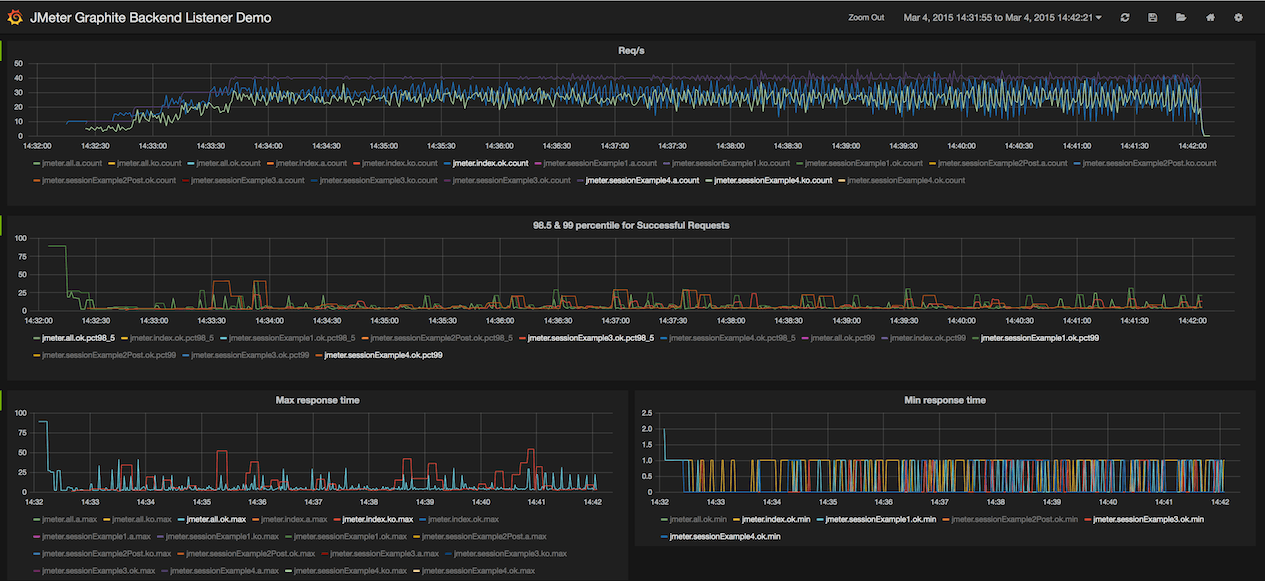17. Real-time results¶
Since JMeter 2.13 you can get realtime results sent to a backend through the
Backend Listener using potentially any backend (JDBC, JMS, Webservice, …) implementing AbstractBackendListenerClient.
JMeter ships with a GraphiteBackendListenerClient which allows you to send metrics to a Graphite Backend.
This feature provides:
- Live results
- Nice graphs for metrics
- Ability to compare 2 or more load tests
- Storing monitoring data as long as JMeter results in the same backend
- …
- InfluxDB
- Graphite
17.1 Metrics exposed¶
17.1.1 Thread/Virtual Users metrics¶
Threads metrics are the following:
- <rootMetricsPrefix>.test.minAT
- Min active threads
- <rootMetricsPrefix>.test.maxAT
- Max active threads
- <rootMetricsPrefix>.test.meanAT
- Mean active threads
- <rootMetricsPrefix>.test.startedT
- Started threads
- <rootMetricsPrefix>.test.endedT
- Finished threads
17.1.2 Response times metrics¶
Response related metrics are the following:
- <rootMetricsPrefix>.<samplerName>.ok.count
- Number of successful responses for sampler name
- <rootMetricsPrefix>.<samplerName>.h.count
- Server hits per seconds, this metric cumulates Sample Result and Sub results (if using Transaction Controller, "Generate parent sampler" should be unchecked)
- <rootMetricsPrefix>.<samplerName>.ok.min
- Min response time for successful responses of sampler name
- <rootMetricsPrefix>.<samplerName>.ok.max
- Max response time for successful responses of sampler name
- <rootMetricsPrefix>.<samplerName>.ok.pct<percentileValue>
- Percentile computed for successful responses of sampler name. You can input as many percentiles as you want (3 or 4 being a reasonable value).
When percentile contains a comma for example "99.9", dot is sanitized by "_" leading to 99_9. By default listener computes percentiles 90%, 95% and 99% - <rootMetricsPrefix>.<samplerName>.ko.count
- Number of failed responses for sampler name
- <rootMetricsPrefix>.<samplerName>.ko.min
- Min response time for failed responses of sampler name
- <rootMetricsPrefix>.<samplerName>.ko.max
- Max response time for failed responses of sampler name
- <rootMetricsPrefix>.<samplerName>.ko.pct<percentileValue>
- Percentile computed for failed responses of sampler name. You can input as many percentiles as you want (3 or 4 being a reasonable value).
When percentile contains a comma for example "99.9", dot is sanitized by "_" leading to 99_9. By default listener computes percentiles 90%, 95% and 99% - <rootMetricsPrefix>.<samplerName>.a.count
- Number of responses for sampler name
- <rootMetricsPrefix>.<samplerName>.a.min
- Min response time for responses of sampler name
- <rootMetricsPrefix>.<samplerName>.a.max
- Max response time for responses of sampler name
- <rootMetricsPrefix>.<samplerName>.a.pct<percentileValue>
- Percentile computed for responses of sampler name. You can input as many percentiles as you want (3 or 4 being a reasonable value).
When percentile contains a comma for example "99.9", dot is sanitized by "_" leading to 99_9. By default listener computes percentiles 90%, 95% and 99%
By default JMeter sends only metrics for all samplers using "all" as samplerName.
17.2 JMeter configuration¶
To make JMeter send metrics to backend add a BackendListener using the GraphiteBackendListenerClient.

17.2 InfluxDB¶
InfluxDB is an open-source, distributed,time-series database that allows to
easily store metrics.
Installation and configuration is very easy, read this for more details InfluxDB documentation.
InfluxDB data can be easily viewed in a browser through either Influga or Grafana.
We will use Grafana in this case.
17.2.1 InfluxDB graphite listener configuration¶
To enable Graphite listener in InfluxDB, edit files /opt/influxdb/shared/config.toml or /usr/local/etc/influxdb.conf, find "input_plugins.graphite" and set this:
# Configure the graphite api
[input_plugins.graphite]
enabled = true
address = "0.0.0.0" # If not set, is actually set to bind-address.
port = 2003
database = "jmeter" # store graphite data in this database
# udp_enabled = true # enable udp interface on the same port as the tcp interface
17.2.2 InfluxDB database configuration¶
Connect to InfluxDB admin console and create two databases:
- grafana : Used by Grafana to store the dashboards we will create
- jmeter : Used by InfluxDB to store the data sent to Graphite Listener as per database="jmeter" config element in influxdb.conf or config.toml
17.2.3 Grafana configuration¶
Installing grafana is just a matter of putting the unzipped bundle behind an Apache HTTP server.
Read documentation for more details.
Open config.js file and find datasources element, and edit it like this:
datasources: {
influxdb: {
type: 'influxdb',
url: "http://localhost:8086/db/jmeter",
username: 'root',
password: 'root',
},
grafana: {
type: 'influxdb',
url: "http://localhost:8086/db/grafana",
username: 'root',
password: 'root',
grafanaDB: true
},
},

17.3 Graphite¶
TODO.

